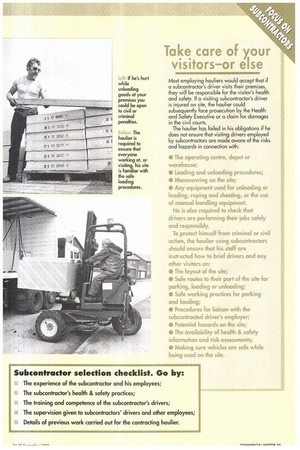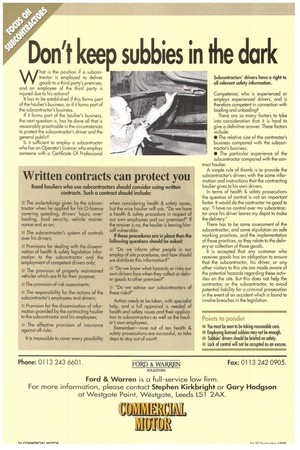Don't take chances
Page 35

Page 36

Page 37

Page 38

If you've noticed an error in this article please click here to report it so we can fix it.
FokDsotznEN with subcontractors
In early September Eastern Traffic Commissioner Geoffrey Simms revoked a large Loughborough operator's licence. The principal grounds of the revocation were that the operator had knowingly used unlicensed subcontractors.
This case is subject to an appeal, but it highlights the serious view taken by the Traffic Commissioners—and the criminal courts—of any fundamental breaches of the licensing system. An operator must satisfy strict quality and financial criteria to obtain and keep his licence. He will fall foul of the criminal law and the licensing system if he attempts to bypass the law and the licensing regulations by employing subcontractors. An operator cannot close his eyes and pass the buck to an unlicensed subcontractor.
If an operator knows that a subcontractor does not have an 0-licence he will be "aiding, abetting, counselling or procuring" that operator to use a vehicle for hire or reward without an 0-licence. That is a criminal offence punishable before a magistrates court with a fine of up to £5,000. More importantly, it is one of the offences for which a TC has the power to suspend, curtail or revoke the operator's licence. Even if there is no criminal conviction, a IC can take into account an operator's use of an unlicensed subcontractor when assessing his repute. The law governing repute is uncompromising: if a IC is not satisfied that a haulier is "of repute" he must revoke the licence. He is allowed no discretion.
In deciding if an individual is "of repute" a IC can consider almost anything he likes, but in particular he will look at relevant convictions or any other information relating to an individual's Fitness to hold an 0-licence.
Consid erable publicity has been given to campaigns by the major trade associations for action to be taken against unlicensed "cowboy" operators, including vehicle seizure. Against that background, an operator who is found to have knowingly used unlicensed subcontractors can expect severe penalties if the matter comes before a TC. The moral must be: never ubcontractor employ a subcontractor 0-licence, without specifically ask
ing if he has an 0licence. Be prepared to ask for a licence number—and if in doubt check with the Traffic Area Office. Do not put your own licence at risk.
How responsible are haulage contractors for the actions of their subcontractors? "Responsibility" has to be assessed in terms of civil liability for the subcontractors' actions or inactions which result in loss or injury to a subcontractor, his employees or anyone else.
Breaches of a haulier's responsibility can result in claims for damages, but responsibility can also be assessed in terms of criminal liability: a breach of the Health & Safety at Work legislation can lead to a Fine and/or a compensation order, or even imprisonment. Criminal charges do not automatically lead to liability in a civil case. Health & Safety legislation places a responsibility on every employer to make sure that, as far as is reasonably practicable, the health and safety and welfare of his employees is maintained. This legislation also places a duty on employers in respect of anyone else who might be affected by the operator's activities.
No shield for hauliers This means that employing a subcontractor does riot provide the haulier with a shield against prosecution for Health and Safety at Work offences.
While there are obligations on the subcontractor, the employing haulier is also required to ensure his compliance with Health and Safety at Work legislation. The Health and Safety at Work Act says: 'Every employer is under a duty to conduct his undertaking in such a way as to ensure, so far as reasonably practicable, that persons not in his employ who may be affected thereby are not exposed to risks to their health and safety." The primary purpose of this section of the Act is the protection of the public and other non-employees From workplace risks. In this context an "undertaking" means "enterprise" or "business"; the operator must understand that anyone engaged as a subcontracting haulier visiting the operating centre or haulier's premises must be protected from injury. Because of this obligation the contracting haulier should select his subcontractors carefully. As part of the selection process the haulier should use a simple checklist (see panel, right).
Take care of your visitors-or else
Most employing hauliers would accept that if a subcontractor's driver visits their premises, they will be responsible for the visitor's health and safety. If a visiting subcontractor's driver is injured on site, the haulier could subsequently face prosecution by the Health and Safety Executive or a claim for damages in the civil courts.
The haulier has failed in his obligations if he does not ensure that visiting drivers employed by subcontractors are made aware of the risks and hazards in connection with:
• The operating centre, depot or warehouse; • Loading and unloading procedures; • Manoeuvring on the site; • Any equipment used for unloading or loading, roping and sheeting, or the use of manual handling equipment.
He is also required to check that drivers are performing their jobs safely and responsibly.
To protect himself from criminal or civil action, the haulier using subcontractors should ensure that his staff are instructed how to brief drivers and any other visitors on: • The layout of the site; • Safe routes to their part of the site for parking, loading or unloading; • Safe working practices for parking and loading; • Procedures for liaison with the subcontracted driver's employer; • Potential hazards on the site; • The availability of health & safety information and risk assessments; • Making sure vehicles are safe while being used on the site.
[Subcontractor selection checklist. Go by: The experience of the subcontractor and his employees; The subcontractor's health & safety practices; The training and competence of the subcontractor's drivers; The supervision given to subcontractors' drivers and other employees; Details of previous work carried out for the contracting haulier.
Don't keep subbies in the dark
What is the position if a subcontractor is employed to deliver goods to a third party's premises, and an employee of the third party is injured due to his actions?
It has to be established if this forms part of the haulier's business, or if it forms part of the subcontractor's business, If it forms part of the haulier's business, the next question is, has he done all that is reasonably practicable in the circumstances to protect the subcontractor's driver and the general public?
Is it sufficient to employ a subcontractor who has an Operator's Licence, who employs someone with o Certificate Of Professional Competence; who is experienced or employs experienced drivers, and is therefore competent in connection with loading and unloading? There are so many factors to take into consideration that it is hard to give a definitive answer. These factors include: • The relative size of the contractor's business compared with the subcontractor's business; • The particular experience of the subcontractor compared with the contract haulier.
A simple rule of thumb is to provide the subcontractor's drivers with the same information and instructions that the contracting haulier gives to his own drivers.
In terms of health & safety prosecutions the question of control is not an important factor, It would do the contractor no good to say: "I have no control over my subcontractor once his driver leaves my depot to make the delivery."
There has to be some assessment of the subcontractor; and some stipulation on safe working practices, and the implementation of those practices, as they relate to the delivery or collection of those goods. It is accepted that any customer who receives goods has an obligation to ensure that the subcontractor, his driver, or any other visitors to this site are mode aware of the potential hazards regarding these activities on the site. But this does not help the contractor, or the subcontractor, to avoid potential liability for a criminal prosecution in the event of an accident which is found to involve breaches in the legislation.
Points to ponder • You must be seen to be laking reasonable care.
• Employing licensed sulkies may not be enough. • Subbies# drivers should be briefed on safety.
• Lack of control will not be accepted as an excuse.
Written contracts can protect you
Road hauliers who use subcontractors should consider using written _ contracts. Such a contract should include: The undertakings given by the subcontractor when he applied for his 0-licence covering speeding, drivers' hours, overloading, load security, vehicle maintenance and so on; The subcontractor's system of controls over his drivers; Provisions for dealing with the dissemination of health & safety legislation information to the subcontractor and the employment of competent drivers only; The provision of properly maintained vehicles which are fit for their purpose; The provision of risk assessments; The responsibility for the actions of the subcontractor's employees and drivers; Provision for the dissemination of information provided by the contracting haulier to the subcontractor and his employees; The effective provision of insurance against all risks.
It is impossible to cover every possibility
when considering health & safety issues, but the wise haulier will ask: "Do we have a health & safety procedure in respect of our own employees and our premises?" If the answer is no, the haulier is leaving himself vulnerable.
If these procedures are in place then the following questions should be asked: "Do we inform other people in our employ of site procedures, and how should we distribute this information?"
"Do we know what hazards or risks our own drivers face when they collect or deliver goods to other premises?"
"Do we advise our subcontractors of these risks?"
Action needs to be taken, with specialist help, and a full appraisal is needed of health and safety issues and their application to subcontractors as well as the haulier's own employees.
Remember—nine out of ten health & safety prosecutions are successful, so take steps to stay out of court!




























































































































